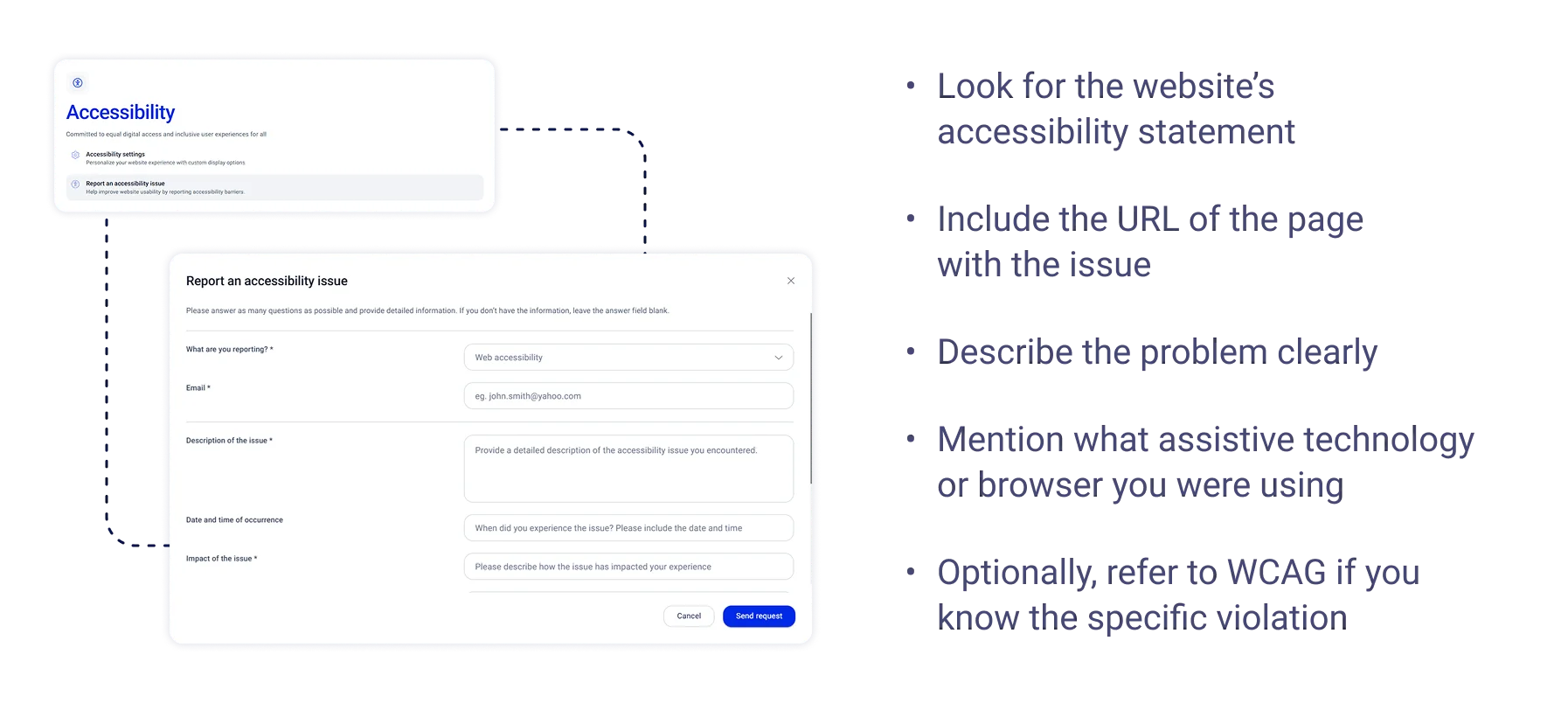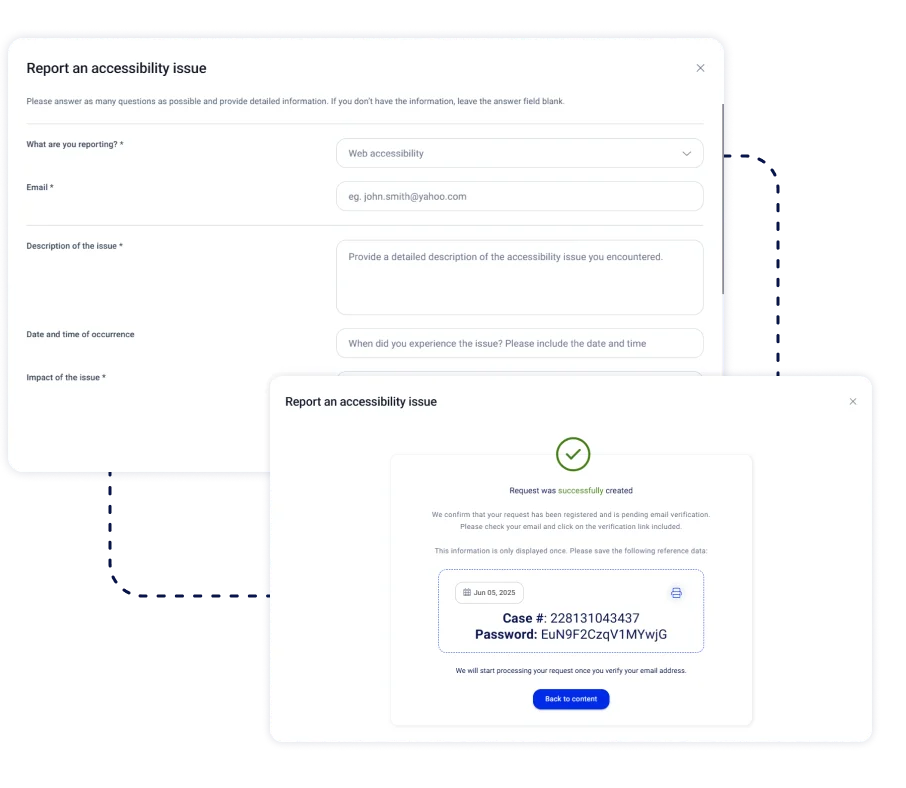How to report accessibility issues using a reporting tool
Accessibility issue reporting at a glance
Accessibility issue reporting gives users a way to report digital barriers, such as inaccessible forms, unlabeled buttons, videos without captions, and images without alt text. This blog post explains how individuals can report these issues using a website’s contact form or listed communication method, and outlines what businesses should expect after receiving feedback. It also guides organizations on collecting accessibility feedback using tools like Clym’s accessibility issue reporting solution, which includes a pre-built form, centralized dashboard with timestamp tracking, and multi-language support.
Why accessibility issue reporting matters
Not every accessibility barrier can be detected by automated scanners. Sometimes, it takes real people encountering real problems, such as a form field that isn’t labeled for screen readers or a video with no captions, to bring these issues to light. That’s where accessibility issue reporting comes in.
It gives users a voice. And it gives businesses a chance to respond, improve usability, and demonstrate that they take digital inclusion seriously.
What is accessibility issue reporting?
Accessibility issue reporting is the process of alerting a website or app owner about a barrier that affects how someone with a disability can use the digital service. These barriers might include:
- Unlabeled buttons or form fields
- Videos without captions
- Features that don’t respond to keyboard navigation
- Images without alt text
A clear and accessible reporting form allows users to explain what went wrong and helps the business understand what to fix.
Why it benefits users and businesses
When users can report accessibility barriers directly, they become part of the improvement process. Businesses gain valuable, real-world feedback that automated tests might miss. It helps:
- Support a more inclusive online experience
- Strengthen user trust and satisfaction
- Address risks tied to laws like the ADA, CHRA, or the European Accessibility Act
For users, it means more access to content, services, and opportunities that might otherwise be blocked by technical or design flaws.
How to report an accessibility issue
Most websites that take accessibility seriously provide a reporting channel. Here’s how to report an issue:
- Find the accessibility statement (typically in the footer)
- Use the contact form or listed email address
- Include helpful details, like:
- The page URL where the issue occurred
- A short description of the issue
- Assistive technology or browser used
- The date and time it happened
Example template:
I encountered an accessibility issue on [URL]. I was using [browser or screen reader] and was unable to [describe the issue briefly].
Save a copy of your message in case you need to follow up later.

What happens after you submit a report
Once submitted, most organizations respond within a few business days. The urgency often depends on how the issue affects functionality. For example:
- A login error or blocked checkout flow may receive high priority
- A visual formatting issue might be addressed later
If you haven’t heard back in two to four weeks, consider sending a follow-up. Some public sector organizations also offer escalation paths for unresolved reports.
How businesses can collect accessibility feedback
Setting up a reliable, accessible way for users to submit feedback can be a challenge. It involves:
- Creating a WCAG-aligned, accessible form
- Deciding what technical details to ask for
- Setting up workflows to route and respond to reports
- Keeping records of submitted reports and resolutions regularly
This process can take time and expertise, especially for small teams without dedicated resources.
Why tools like Clym’s accessibility reporting solution help
Instead of building a custom system, many organizations choose ready-made tools that make the process easier. Clym offers an accessibility issue reporting solution that integrates directly into your website through its privacy and accessibility widget.
With Clym, businesses can:
- Add a reporting tool without technical knowledge
- Use a pre-built accessible form
- Offer multi-language support
- Manage reports from a centralized dashboard where everything is timestamped and tracked throughout the reporting process
- Automatically generate an accessibility statement
Explore Clym’s accessibility reporting tool

Legal context and accessibility reporting best practices
Many laws around the world encourage or require websites to be usable by people with disabilities and to offer a way for users to report problems. These include:
- ADA (United States) – Requires businesses and public organizations to make websites usable for people with disabilities and respond when accessibility issues are reported.
- European Accessibility Act (EAA) – Requires websites and apps across the EU to follow accessibility standards and provide a method for users to submit feedback about accessibility problems.
- Equality Act (United Kingdom) – Prohibits discrimination and expects websites to take reasonable steps to remove digital access barriers.
- CHRA (Canada) – Protects the rights of individuals with disabilities and expects service providers, including websites, to accommodate accessibility needs and provide a way for concerns to be raised.
Best practices include:
- Publishing a visible accessibility statement
- Offering a clearly labeled reporting form
- Documenting and reviewing reports and how they were addressed
Conclusion: Inclusive experiences start with feedback
Accessibility issue reporting connects real users with websites and helps uncover barriers that need to be fixed. It’s a practical way to improve usability and show that digital inclusion is part of your strategy.
Whether you're reporting an issue or collecting feedback, having a process in place benefits everyone.
FAQs
Look for the accessibility statement, usually in the website’s footer. Use the contact form or listed email, and include the page URL, a description of the issue, what technology you used, and the time it occurred.
Common examples include unlabeled buttons or form fields, videos without captions, content that doesn’t work with keyboard navigation or screen readers, and images missing alternative text.
Yes, in many places. Laws like the ADA, CHRA, EAA, and Equality Act expect organizations to make digital services usable and to respond when users share feedback about barriers.
Clym provides an accessibility issue reporting solution with a built-in form, multi-language support, and a centralized dashboard. Reports are timestamped, tracked, and managed in one place. An accessibility statement is also generated as part of the setup.
A strong form includes fields for the page URL, issue description, browser or assistive tech used, date and time, and optional contact details. It should also follow accessibility standards so all users can submit it easily.
Most businesses respond within a few days. If there’s no response within two to four weeks, consider sending a follow-up or looking for another way to escalate your concern.